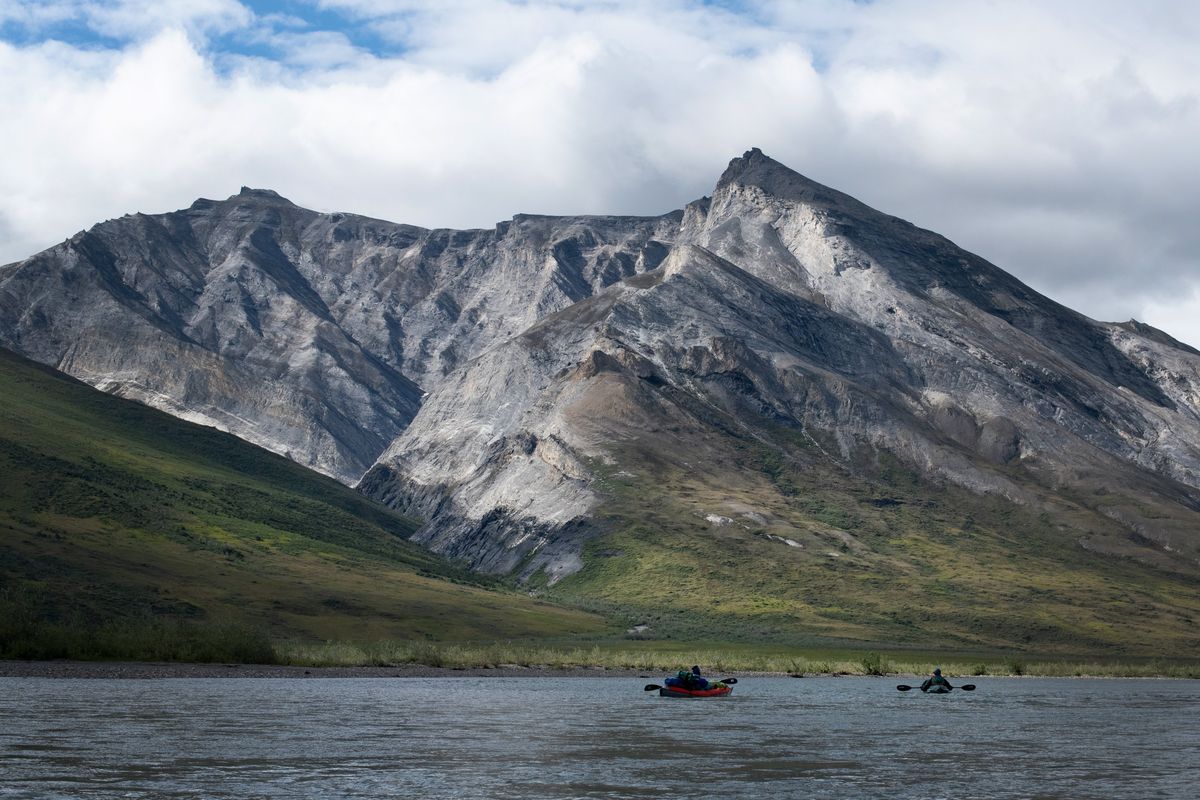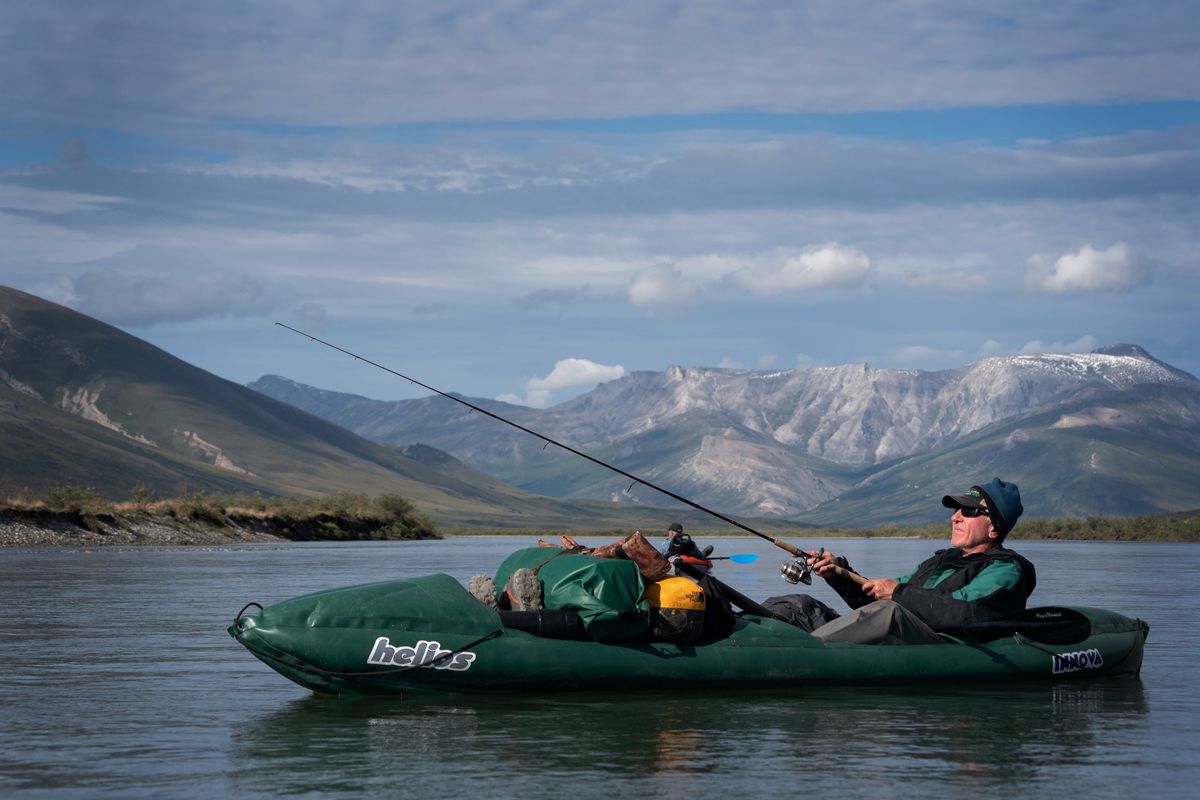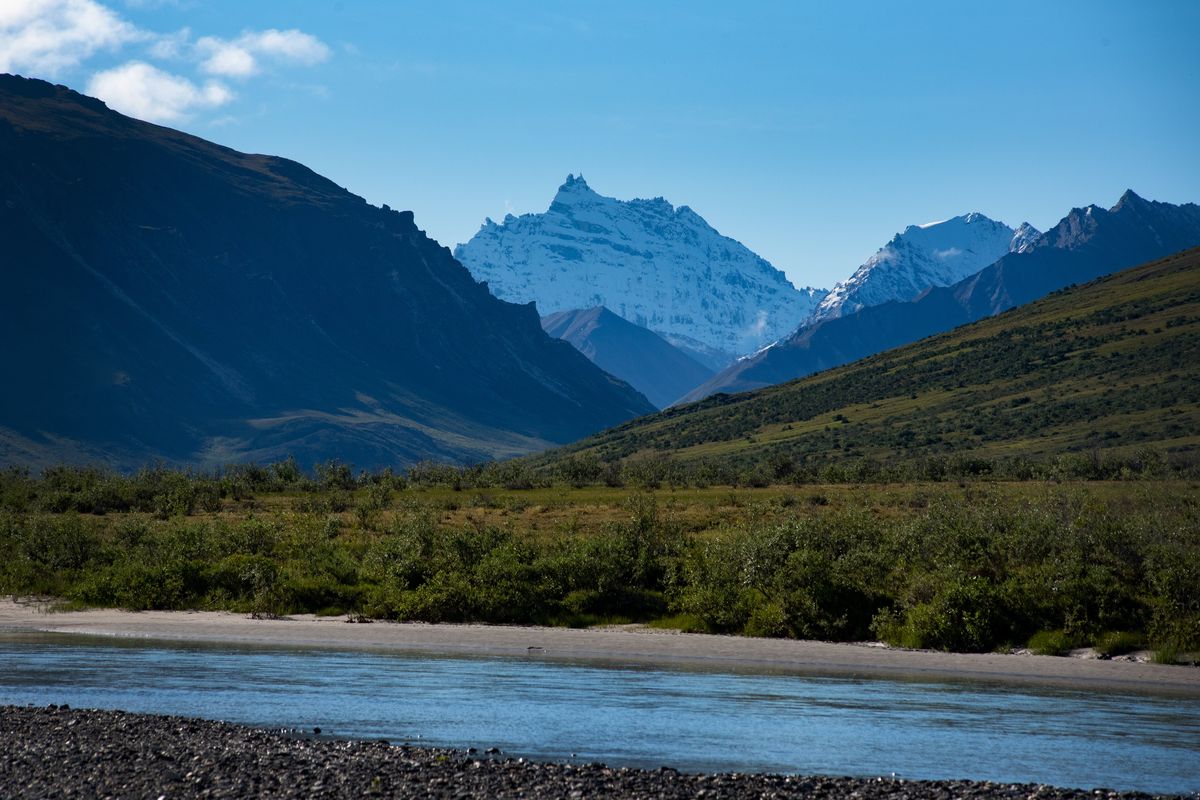Part Two: Entering a wilderness mindset on the Noatak River
Cary Kopczynski fishes while paddling down the Noatak River on July 30. (Eli Francovich/The Spokesman-Review)Buy a print of this photo
This is the second in a four-part series about kayaking the Noatak River in the Arctic Circle.
Noatak River, Alaska, July 29 – Despite being hundreds of miles from the nearest road, I can’t stop seeing boat ramps, black asphalt cutting through the steep river-eroded banks of the Noatak River and dipping into the icy water. Of course, these aren’t boat ramps, they’re the result of some sedimentary process, pressing rock and sand down, flattening it out, shale like upon closer observation.
Yet I see a human-made ramp. That’s not the only trick my brain pulls. Big washes and cuts entering the river look like graded roads. Or there is the bundle of driftwood I swear, from afar, is a kiosk, as if I’d accidentally floated into River Park Square.
It’s our first full day on the Noatak River, a river that anchors the largest undeveloped watershed in North America. It flows through the Gates of the Arctic National Preserve and the Noatak National Preserve, two protected areas that are, when combined, seven times larger than Yellowstone National Park. While these are facts I know, my brain continues to superimpose structures I’m familiar with upon a landscape that is anything but. The others on the trip confirm that they, too, are seeing human-made objects where none exist.
We’re drifting now, the sun breaking through the morning clouds, although Mount Igikpak, which is behind us, is still shrouded in a veil that has left the summit a mystery. It’s hard to say how fast the river is moving. We hope for 4 mph, but it could be closer to 2. Either way, we’ve established a rhythm that is to last the entire trip.
Stroke, stroke, stroke, drift, repeat.
The wolf interrupts this meditation.
We approach an arcing leftward bend in the river, the foothills of the Brooks Range rising sharply from the river. These hills are barren, grass wavering in the wind, with not a tree in sight. Then I see movement on the hillside above, a flash of white and, as my eyes focus, I realize it’s a lone white wolf trotting uphill.
I point the wolf out to Jim Wood, who scans the ridgeline and locks in on the animal, too. I consider unpacking my camera, but the animal is too far for the lens I have and I’m afraid I’ll miss it if I take the time needed. So instead, I grab my binoculars, which are sitting on my lap. The wolf has stopped moving, instead staring down at us with evident curiosity. We drift toward him and he continues his trot uphill, effortlessly covering ground that would take us hours. It’s a rugged, desolate place; one where the summer wind carries an icy bite, foreshadowing the cold and dark that reigns much of the year (ice everywhere, -40 degrees). The fact that any animal can survive here full time is hard to believe.
July 30: Chris Kopczynski is sick. Stomach problems. Today he talked about leaving the trip early, a discussion only made possible by the fact that Eric, the bush pilot, needs only 1,000 feet of gravel to land. That combined with the various satellite communication devices we have (three Garmin InReaches and a Iridium satellite phone) means that if necessary Kop can leave more or less anytime
We look at the map at lunch and the distance ahead seems impassable. So many meanders. So many miles. Every adventure sounds doable from the comfort of home and traveling 40-river miles a day sounds reasonable while drinking coffee in a hotel. It’s a different story when you’re sitting a foot above the water, feeling the wind against your face. Still, I feel good, happy to be out and not too concerned about how far we make it, although Chris’ ailments concern us all.
July 31: A familiar anxiety returns. I worry I won’t have enough food. I packed 20 freeze-dried dinners and 17 freeze-dried breakfasts. I also brought 12 bagels, a jar of peanut butter, two bags of beef jerky, one bag of almonds, one bag of trail mix, two bags of dried fruit and a bag of chocolate covered almonds. Plus, the bad weather at the beginning of the trip delayed us three days giving me an even larger caloric buffer.
Objectively, there is no problem. Although I will run out of lunches (I should have bought one more bag of bagels) barring nuclear war, or some freak accident in which we all lose our satellite communication devices, the chances of me starving are near zero.
And yet I worry. I count my meals multiple times. I read the calorie information. I ration snacks ruthlessly. This is a familiar anxiety because, in my experience, when in the wilderness a primal concern for the basics returns.
Where do I sleep tonight? When and what do I eat? Am I warm enough? These considerations dominate a day.
As for Chris’ stomach problems? They’ve cleared up and spirits are high. The weather has been amazing, clear blue skies and a wind that picks up only in the afternoon, when we’re near finished with the paddling day anyway. We’ve all commented on how so far it’s been more pleasant than we expected. In fact the sun, which only dips behind the horizon at 1 a.m., grows tiresome and I wish for darkness or clouds.
Aug 1: Today we saw a musk ox, a wild creature with a long shaggy coat that looks like it belongs in an ice age, not in the sun. We spot him ahead on the river bank around 11 a.m.. We left the mountains this morning and have entered the plains, rolling hills as far as the eye can see. At first glace we think he’s a grizzly bear, but as we draw close it becomes clear this is a big, hoofed animal. Drifting by, he stares at us from the bank above. I jump out and take photos. Chris and Cary, whose ancestors were Polish, joke that they’re probably the first Poles this musk ox has seen.
Like the wolf, staring at that animal is an intense experience. While the musk ox has certainly never seen two Polish brothers, it’s also possible he’s never seen humans, a remarkable fact in a world of nearly 8 billion. We humans have colonized every corner of this planet, to be in a place that’s isolated from that influence, however thinly, is startling.
Aug. 2: We’re all settling into the routine of this trip. Waking up around 6 a.m. and on the river by 8 a.m. Lunch at noon and then, usually, camp by 4 or 5 p.m. Finding camp is an exciting process, paddling ahead looking for flat sandbars, or gravel bars with finer rock. Several times we abandon a campsite because of grizzly bear sign. I haven’t seen any bears yet on this trip, although Jim and Cary saw one the first day. Today we saw four more musk ox but didn’t come nearly as close as we did yesterday.
These animal sightings have me thinking about “wilderness.” While the Noatak’s scenery is stunning, for me the true draw is the feeling of isolation and self-sufficiency that comes with being here. Carrying everything you need in your boat. Finding camp when and where you can.
All of which is a myth, of course.
While we are physically far, our various devices and conveniences continue to connect us. Using my Garmin, I text with family and friends nearly every day. An online map updates my location automatically every 10 minutes. My food is dehydrated and packaged, dependent on a vast global supply chain. We cook with gas, pulled from the earth. Cary, Chris and Jim call their wives. We check online maps and consider the river ahead.
And in truth, while a musk ox or a wolf appear to be ruggedly self-sufficient from a drifting kayak – surviving conditions that boggle the mind – both are social animals. Animals that depend on their peers just as much as humans do. Perhaps that’s the true beauty of a place like the Noatak. It reminds me that at the end of the day I’m not so different than a herd or pack animal, dependent on the same necessities: food, water, shelter and companionship.




